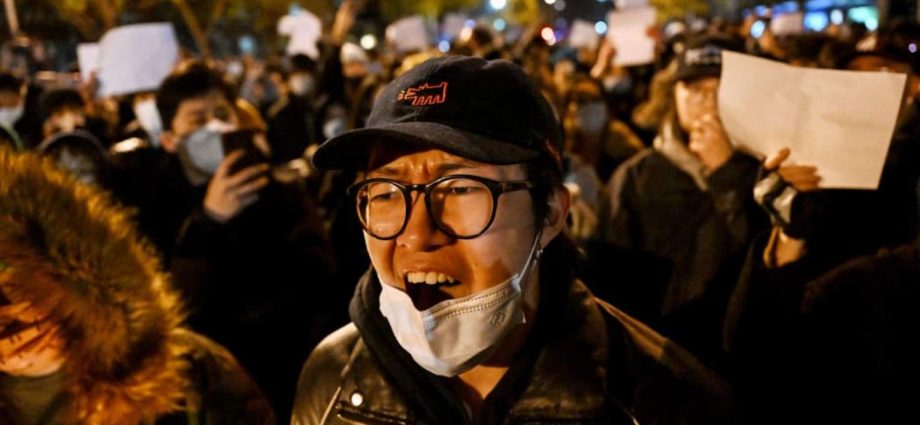In early December 2022, China announced that it was terminating the itinerary code, which had tracked people’s movements in public spaces to determine if they had been to areas of high risk for the transmission of Covid-19.
The itinerary code worked alongside China’s health code (jiankang ma) which tracked individuals’ Covid-19 status, including vaccination status and previous diagnoses, to generate a colored (red, yellow or green) code indicating the person’s likelihood of Covid-19 infection.
While the health code was not terminated entirely, some of its services, like the colored code, have now ceased to operate. On November 9, 2022, despite these changes, China’s government announced plans to further digitize the national health system and associated services.
This policy announcement forms part of China’s 14th Five Year Plan (2021–2025). The overarching objective is to create a framework for building a nationwide platform that provides “unified” and “authentic” health information to the public.
According to the announcement, the platform will be powered by its ability to share data between health institutions and other social institutions across China by 2025.

The announcement, though, was vague and full of ideological rhetoric. But its repeated emphasis on building nationwide digital infrastructure, synthesizing health data and other social and personal information, has provided some clues about the underlying imperatives of this project.
Data synthesis is the centerpiece of the newly announced project. The announcement lays out a specific plan to link residents’ national ID (shenfen zheng) numbers and other forms of identification with their health information. This is to create what the government calls “one code for all” — for all people and for all aspects of life in China.
Linking health service platforms with their users’ personal information has already been trialed in China during the Covid-19 pandemic. The itinerary code and health code linked Chinese residents’ personal information, travel details and even biometrics in order to pre-determine their health status.
Even before the Covid-19 pandemic, data-driven technologies have long been key to the Chinese government’s regulatory regime and social governance. Expanding the technological logic of Covid-19-tracking apps into the daily lives of the Chinese population has been on agenda for the Chinese government since the early days of the pandemic.
This plan to “data-fy” health information connects with other techno-social developments in China — including the embrace of cashless transactions, the digitization of utilities and government service provision and the increasing reliance on apps and algorithms to promote social morality and nationalism.
The proposed national health platform is one of many national infrastructure projects in China that can be considered as part of a push for political centralization. Infrastructure is built to ensure the central government’s authority is respected and reinforced.
The announcement of the new national health platform repeatedly emphasized creating “a single platform” to enable data sharing between existing e-government platforms and other databases across all administrative units in China.
The announcement’s repeated assertion of the need to centralize data is an admission of the tensions that exist between the central government and local authorities over data governance and health management, which is neither new nor exclusive to the Covid-19 pandemic.
Although China’s three major telecom companies jointly provided the itinerary code, the health code has many local versions and local authorities administer the data that is collected. Many local health codes are not compatible with each other and are not recognized outside of their local jurisdictions.
Local variations have undermined the central government’s objective of accurate pandemic prevention and control and have created confusion, chaos and led to unrest.
It could be argued that Covid-19 tracking codes achieved little in protecting China’s health system and its population during the pandemic. But these failures might have strengthened the central government’s desire to pursue administrative centralization.

The ambition to build a national health platform shows the central government has convinced itself that political centralization can only be achieved through the centralization of the flow of data.
The centralization of administrative power points to a bigger ambition of the Chinese government which is the construction of a unified imagination of Chinese culture and the Chinese state. This is a pillar of Chinese President Xi Jinping’s political ideology.
In August 2021, China’s Ministry of Commerce proposed that live streamers should use Mandarin in their shows. It has been reported that the widely used app Douyin (China’s domestic version of TikTok) has pulled the plug on live streamers streaming exclusively in Cantonese.
The central government’s crackdown on cultural pluralism serves as a broader context in which to interpret its ongoing efforts to control the flow of data. Controlling data can build technological barriers to protect the Chinese Dream (zhongguo meng).
That is the ideological framework that puts the interests of the Chinese Communist Party and Xi himself at the core of nation-building and China’s cultural imagination.
Wilfred Yang Wang is a Lecturer in Media and Communications Studies at the University of Melbourne.

